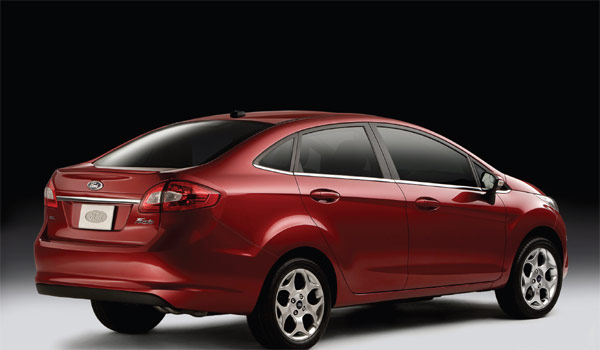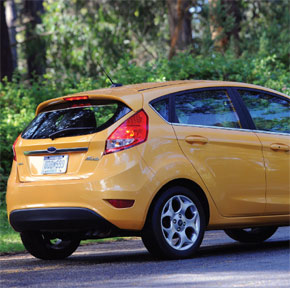
They say the world is becoming a smaller place and with natural resources being demanded by more and more countries, costs are increasing in the auto market as well. In Europe the price of fuel is nearly twice what it is here, so the call for smaller fuel efficient vehicles has been strong. That same cry is coming to America and success is being found by manufacturers including Mini and Honda. So how are our domestic brands reacting to smaller is better? For Ford Motor Company, the 2011 model year brings the introduction of the subcompact Ford Fiesta that has been very successful in Europe, and is finally available here.
The 2011 Ford Fiesta was designed and developed in Europe; with a Euro feel. In the past, automotive manufacturers would sell small cars but never make any real money on the sale. These were considered lost leaders and stepping stones for future up-sales. Those cars had low-budget features and quality; however, things do change!
Car companies know that Americans demand high quality features, gadgets, style, and comfort, so they are designing and building small cars that have bold designs, possess the comforts of home, and are loaded with features. For Ford, this has generated larger transaction prices and satisfied customers who are reaping the rewards!
In Fords 2011 lineup, the Fiesta is the smallest vehicle sold in the Ford stable, measuring 15-inches shorter than the Focus. The Fiesta, with a successful track record in Europe, is among the first of a fleet of vehicles designed and sold ‘oversees’ to finally make it to the U.S. shores. Ford believes the subcompact Fiesta will attract first-time buyers and even some baby boomers. To reach its main audience, Ford created a marketing plan that has been centered on social media including Facebook.
The 2011 Ford Fiesta is available in two body styles – Hatchback and Sedan and four trim levels. The trim levels are: SE Hatchback ($15,795), SES Hatchback ($17,795), S Sedan ($13,995), SE Sedan ($14,995), and SEL Sedan ($16,995). All prices include a $675 destination fee.
All models come with a 4-cylinder 1.6-liter engine mated to a 5–speed manual transmission that produces 28 mpg in the city and 37 mpg on the highway. The Fiesta is also offered with a new automatic transmission technology that acts like an automatic, but gets the fuel economy of a manual transmission. This optional six-speed automatic transmission comes with PowerShift™ for $1,070.00 and earns an estimated 30 mpg in the city and 40 mpg on the highway. The Fiesta’s 4-banger engine manages to run 120 horses, which produces some pretty good get-up-and-go power.
Ford’s European design team carved out an edgy profile with sharp angles, a steeply ranked windshield and large aggressive headlamps. The front lower grille opening has what Ford calls a reverse trapezoid and large side intake ports delivering an in-your-face look. This dramatic style is favored by the young demographics that Ford is aiming at as new owners of the Fiesta.
A feature that in my opinion is an “about-time” for Ford is the remote key entry, which is where the door handle has a small black button that when pressed, detects the key fob in your pocket. This feature unlocks the (front) door and allows you to open the door without digging for a key. I understand this may seem like a minor convenience feature, but it has been available on both higher priced, and mid-range cars for a while, but as far as I can tell this is the first time it is available on a Ford.
The interior is sharply dressed with proud eagle-like arches incorporated into the center dash. A blend of black and brushed metallic trim-touches adds a sport flare and stylish quality. The ‘info’tainment controls are housed in a metallic shell center-dash, and runs the interior theme. Planted above the center dash is a data screen that displays everything from radio information to phone activity.
The front seats felt comfortable with a rich feel to the material, and had enough side and bottom bolsters to keep me properly positioned during turns. Overall interior quality was above what you would expect with plenty of soft-touch points. Ford added features that you wouldn’t typically find in a car this size including leather seat surfaces, SYNC voice activated system, heated front seats and lighted cup holders; to name a few.
Ride quality and handling of the Fiesta felt more confident than some of its competitors like the Toyota Yaris and Nissan Versa. When pushing it to the limit I felt a little understeer (which is when the car wants to go straight instead of turning), but nothing that couldn’t be controlled. During typical driving situations the car reacted and responded well.
Room for improvement:
- No center arm rest
Cool Features:
- Push button start
- Smart key with remote keyless entry
The 2011 Fiesta safety equipment includes seven airbags: dual stage frontal, front seat side impact, side curtain and driver knee. Also standard is antilock brakes, electronic stability control, child safety seat anchors (LATCH) and tire pressure monitoring system.
In Summary – The 2011 Fiesta is an important entry for Ford and its small car effort, since this category is growing in popularity. It has been designed and equipped to be profitable and delivers an upscale subcompact vehicle that is fun to drive and fuel efficient. The Fiesta is another example of Ford building a vehicle that people want, which meets and exceeds their expectations.
For more information and a complete list of features and specifications go to www.autofastracks.com.
Specifications
2011 Ford Fiesta SES Hatchback

Base price: $17,795 as driven: $18,890 (including destination and optional equipment)
Engine: 1.6-Liter 4-cylinder
Horsepower: 120 @ 6000
Torque: 109 foot pounds @ 4250 rpm
Transmission: 5-speed manual transmission with PowerShift™
Drive: Front Wheel-Drive
Seating: 5-passenger
Turning circle: 34.4 feet
Cargo space: 26 cubic feet
Curb weight: 2575 pounds
Fuel capacity: 12 gallons
EPA mileage: 37 highway, 28 city
Wheel Base: 98 inches
Warranty: 3 years/36,000 miles
Also consider: Chevrolet Aveo, Honda Fit, Nissan Versa, Toyota Yaris
Leave a Reply